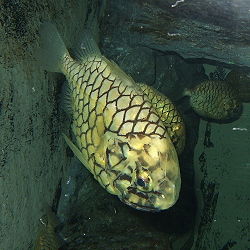
Monocentridae
Encyclopedia

Fish
Fish are a paraphyletic group of organisms that consist of all gill-bearing aquatic vertebrate animals that lack limbs with digits. Included in this definition are the living hagfish, lampreys, and cartilaginous and bony fish, as well as various extinct related groups...
of the family
Family (biology)
In biological classification, family is* a taxonomic rank. Other well-known ranks are life, domain, kingdom, phylum, class, order, genus, and species, with family fitting between order and genus. As for the other well-known ranks, there is the option of an immediately lower rank, indicated by the...
Monocentridae. The family contains just four species
Species
In biology, a species is one of the basic units of biological classification and a taxonomic rank. A species is often defined as a group of organisms capable of interbreeding and producing fertile offspring. While in many cases this definition is adequate, more precise or differing measures are...
in two genera
Genus
In biology, a genus is a low-level taxonomic rank used in the biological classification of living and fossil organisms, which is an example of definition by genus and differentia...
, one of which is monotypic
Monotypic
In biology, a monotypic taxon is a taxonomic group with only one biological type. The term's usage differs slightly between botany and zoology. The term monotypic has a separate use in conservation biology, monotypic habitat, regarding species habitat conversion eliminating biodiversity and...
. Their distribution is limited to tropical and subtropical waters of the Indo-Pacific
Indo-Pacific
The Indo-Pacific is a biogeographic region of the Earth's seas, comprising the tropical waters of the Indian Ocean, the western and central Pacific Ocean, and the seas connecting the two in the general area of Indonesia...
. Pinecone fishes are popular subjects of public aquaria
Aquarium
An aquarium is a vivarium consisting of at least one transparent side in which water-dwelling plants or animals are kept. Fishkeepers use aquaria to keep fish, invertebrates, amphibians, marine mammals, turtles, and aquatic plants...
, but are both expensive and considered a challenge for the hobbyist to maintain.
Physical description
These fish are aptly named; their rounded, compressed bodies are completely covered (with the exception of the caudal peduncle) with very large, strong platelike scaleScale (zoology)
In most biological nomenclature, a scale is a small rigid plate that grows out of an animal's skin to provide protection. In lepidopteran species, scales are plates on the surface of the insect wing, and provide coloration...
s called scutes which are fortified with prominent ridges. The first dorsal fin
Dorsal fin
A dorsal fin is a fin located on the backs of various unrelated marine and freshwater vertebrates, including most fishes, marine mammals , and the ichthyosaurs...
is composed of 4-7 strong, disunited spines which vary in length; the second dorsal fin and anal fin are small, spineless and rounded, situated far back of the convex head. The pelvic fin possesses one large erectile spine which can lock into place. The pectoral fins are somewhat elongate and the caudal fin is truncate.
Coloration is typically a yellow to orange, the scales dramatically outlined in black. The eyes are relatively large, and the mouth oblique and subterminal. On either side of the lower jaw there is a bioluminescent
Bioluminescence
Bioluminescence is the production and emission of light by a living organism. Its name is a hybrid word, originating from the Greek bios for "living" and the Latin lumen "light". Bioluminescence is a naturally occurring form of chemiluminescence where energy is released by a chemical reaction in...
organ called a photophore
Photophore
A photophore is a light-emitting organ which appears as luminous spots on various marine animals, including fish and cephalopods. The organ can be simple, or as complex as the human eye; equipped with lenses, shutters, color filters and reflectors...
: a pale light is produced by symbiotic
Symbiosis
Symbiosis is close and often long-term interaction between different biological species. In 1877 Bennett used the word symbiosis to describe the mutualistic relationship in lichens...
bacteria within the organ, and the colour of the light varies with ambient light levels—orange by day and blue-green at night.
The pineapplefish
Pineapplefish
The pineapplefish, Cleidopus gloriamaris, is a species of fish in the family Monocentridae, and the sole member of its genus. It is also known as the knightfish or the coat-of-mail fish, due to the armor-like scales covering its body, and the port-and-starboard light fish, as it has a pair of...
, Cleidopus gloriamaris, is the largest species, reaching up to 30 centimetres (11.8 in) in length. There is no apparent sexual dimorphism
Sexual dimorphism
Sexual dimorphism is a phenotypic difference between males and females of the same species. Examples of such differences include differences in morphology, ornamentation, and behavior.-Examples:-Ornamentation / coloration:...
.
Life history
Pinecone fishes stick to the sublittoral zone, and are associated with ledges and caves, rocky and (occasionally) coral reefCoral reef
Coral reefs are underwater structures made from calcium carbonate secreted by corals. Coral reefs are colonies of tiny living animals found in marine waters that contain few nutrients. Most coral reefs are built from stony corals, which in turn consist of polyps that cluster in groups. The polyps...
s over a hard bottom. Found at 10–200 metres depth (with juveniles frequenting the shallower end of this range), Pinecone fishes are nocturnal and form schools.
The photophores are thought to play a role in attracting the zooplankton
Zooplankton
Zooplankton are heterotrophic plankton. Plankton are organisms drifting in oceans, seas, and bodies of fresh water. The word "zooplankton" is derived from the Greek zoon , meaning "animal", and , meaning "wanderer" or "drifter"...
upon which the fish feed; intraspecific communication may also be a use for the light. Little is known of their reproductive biology, but they are assumed not to guard their brood.
Species
- Genus Cleidopus
- PineapplefishPineapplefishThe pineapplefish, Cleidopus gloriamaris, is a species of fish in the family Monocentridae, and the sole member of its genus. It is also known as the knightfish or the coat-of-mail fish, due to the armor-like scales covering its body, and the port-and-starboard light fish, as it has a pair of...
, Cleidopus gloriamaris De Vis, 1882.
- Pineapplefish
- Genus Monocentris
- Monocentris japonicaMonocentris japonicaMonocentris japonica is a pinecone fish of the family Monocentridae, found in the tropical Indo-West Pacific oceans, at depths of between 10 and 200 m. Its length is between 8 and 15 cm.-References:...
(HouttuynMartinus HouttuynMaarten Houttuyn or Houttuijn , Latinised as Martinus Houttuyn, was a Dutch naturalist.Houttuyn was born in Hoorn, studied medicine in Leiden and moved to Amsterdam in 1753. He published many books on natural history. His areas of interest encompassed Pteridophytes, Bryophytes and Spermatophytes...
, 1782). - Monocentris neozelanicus (Powell, 1938).
- Monocentris reedi Schultz, 1956.
- Monocentris japonica

